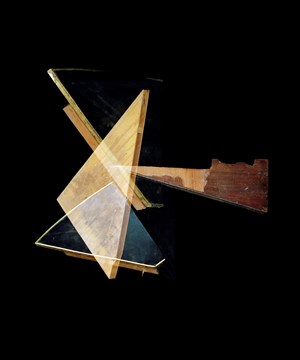
History and the present meld in the works of four artists at the New Vision/New Generation exhibit at Julie Saul Gallery in New York.
History and the present meld in the works of four artists at the New Vision/New Generation exhibit at Julie Saul Gallery in New York. Distinguished photographers László Moholy-Nagy and Luigi Ghirri are shown alongside young gallery artists whom their respective influence has inspired, Alejandra Laviada and Andrea Grützner. The show is designed to illustrate how the artistic past affects the present and future we realize in contemporary art forms. Viewing the exhibition as a whole reveals many modern traces of the precedent’s impact and an overarching continuity in the art of yesterday and today, as well as what will likely be the art world of tomorrow.
The first instructor to introduce experimental photography to the Bauhaus, László Moholy-Nagy (1895-1946) is noted for his “New Vision” and widespread post-WWII influence. His photograms were made by placing diverse materials directly on photographic paper, which was then exposed and arranged to create unique, mysterious and evocative forms.
Mexican artist Alejandra Laviada (b.1980) creates deep, dark spaces that resemble the design and abstraction of Moholy-Nagy’s photograms. In her Geometry of Space series, Laviada uses discarded building materials that are multiply exposed in the camera to form powerful enigmatic compositions. She embraces Moholy-Nagy’s principle that each work must find its medium- in this case, abstract photography.
AD: In keeping with the theme of the exhibition, how do you believe the past influences the present in art and in life?
Alejandra Laviada: I think everything we are exposed to in life influences us as artists. The combination of all our experiences is what makes each artist's work their own. I studied painting before photography, and this shaped the way I approach photography and my process as an artist. It is somehow embedded in the images I make, sometimes unconsciously. Because of this, many of my references as an artist are not photographers, but instead painters or sculptors.
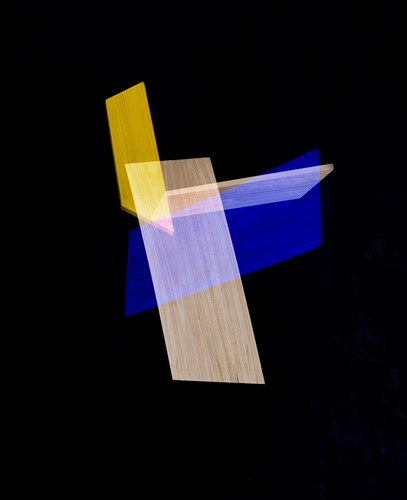
Alejandra Laviada, Blue, Yellow Intersection, 2014. Pigment print, 37 x 30” image, 42 x 35” sheet, edition of 5 © Alejandra Laviada, courtesy of Julie Saul Gallery, New York
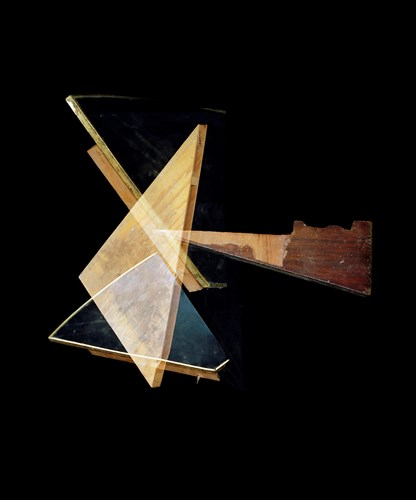
Alejandra Laviada, Spatial Triangles, 2014. Pigment print, 24 x 20” image, 29 x 25” sheet, edition of 5 © Alejandra Laviada, courtesy of Julie Saul Gallery, New York
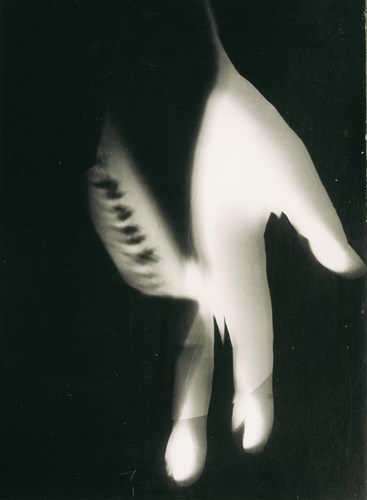
László Moholy-Nagy, Photogramm, 1926. Unique vintage print, 8 3/4 x 11 1/2” © Artists Rights Society, courtesy of Julie Saul Gallery, New York
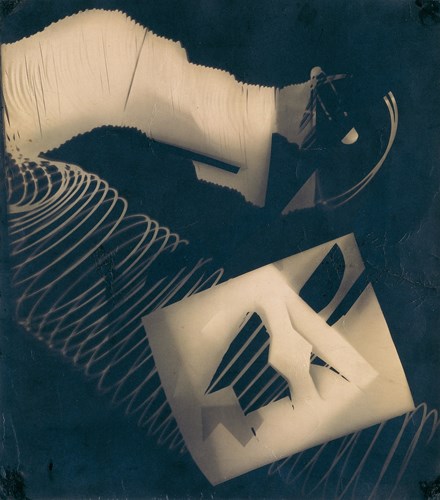
László Moholy-Nagy, Photogramm, 1929. Unique vintage print, 10 x 8 3/4” © Artists Rights Society, courtesy of Julie Saul Gallery, New York
AD: How did the prior generation of artists and your counterpart in the exhibition, László Moholy-Nagy, influence your work currently shown at the gallery?
Alejandra Laviada: For this particular series, I revisited many of Moholy-Nagy's paintings as a starting point for the work. I focused on his paintings of intersecting geometric planes suspended in space, and built various three-dimensional wooden objects using the same proportions in various sizes. These then became the primary language for most of the images in Geometry of Space.
Being both a painter and a photographer, Moholy-Nagy’s approach to photography comes from a painterly perspective, and he believed that “the camera should be liberated from its role of recording the natural world in order to create abstract pictures of light and form.” Having a painting background myself, my photographic process also has its roots in painting and in finding ways to push photography’s boundaries, in relation to other artistic mediums. Moholy-Nagy's ideas strongly resonate with my own process, so many years later.
AD: How do you feel that the past will continue to inspire your future work as an artist?
Alejandra Laviada: What is important for me in this or any work, is to understand and acknowledge what inspired it, and find my own voice in the images I make. I am not interested in copying something that has already been done, but in finding inspiration from what others have done and building on that. I want to create my own discourse in the context of the themes that are present throughout my work.
The second component of the New Vision/Next Generation exhibition features Luigi Ghirri (1943-1992), who pioneered the use of color, merging document and concept in diverse bodies of work in the 1970’s. Well-known particularly in Europe, Ghirri’s work has entered the canon along with such early color practitioners as Eggleston and Stephen Shore.
East German born Andrea Grützner (b.1984), expresses herself through architectural subjects and urban geometry– first in her Erbgericht (guest house) series, and as photographer in residence in Koblenz, with das Eck (the corner). Juxtaposing the old and the new in her materials and subject matter, Grützner’s project is infused with the irony, humor, optimism and keen graphic sense that Ghirri too demonstrated.
AD: In keeping with the theme of the exhibition, how do you believe the past influences the present in art and in life?
Andrea Grützner: My work is driven by an interest in how we perceive spaces, both contextually and visually. As for my own pictures, I am enticed by man-made structures and surfaces, which are soaked with memories and history. These are haunting traces, which often seem partly inaccessible. A photograph is an index, referencing a spatial and temporal relationship belonging to the past, but revealing it in a strange way in the present.
![]()
Luigi Ghirri, Ferrara (from Topographie - Iconographie), 1981. Vintage cibachrome, 12 x 16” © The Estate of Luigi Ghirri, courtesy of Matthew Marks Gallery
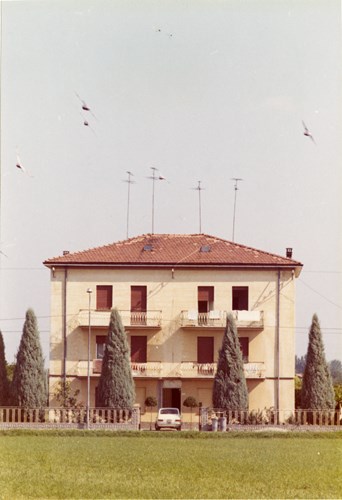
Luigi Ghirri, Modena (from Colazione sull’erba), 1973. Vintage chromogenic print, 6 1/2 x 4 1/2” © The Estate of Luigi Ghirri, courtesy of Matthew Marks Gallery
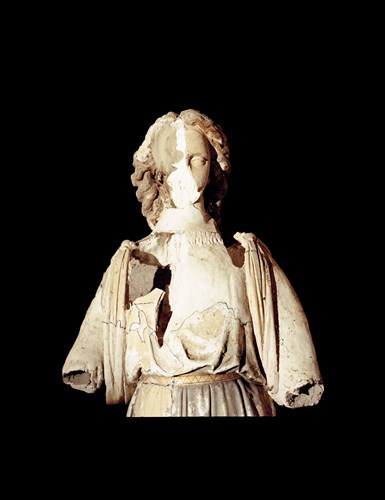
Andrea Grützner, Untitled (artefact 5), 2015-16. Pigment print, 10 x 7 3/4”, edition of 5 © Andrea Grützner, courtesy of Julie Saul Gallery, New York
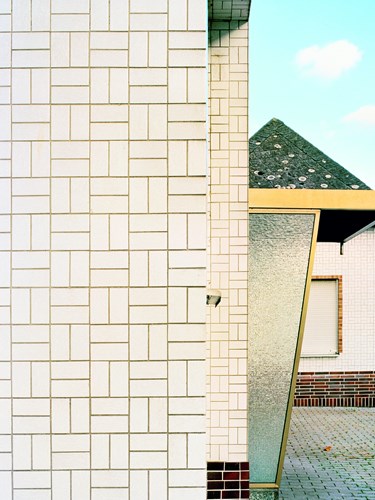
Andrea Grützner, Untitled (quad wall), 2015-16. Pigment print, 12 1/2 x 9 3/8”, edition of 5 © Andrea Grützner, courtesy of Julie Saul Gallery, New York
AD: How did the prior generation of artists and your counterpart in the exhibition, Luigi Ghirri, influence your work currently shown at the gallery?
Andrea Grützner: During my first visit to Koblenz, one of Germany’s oldest cities, I noticed that the old and the new mix in an unusual way. The city was largely destroyed during the Second World War and afterwards rebuilt mostly utilizing the typical postwar architecture of the region, yet the view of the city is not entirely determined by this. In Koblenz, I noticed many slightly surreal details that made me smile. These could be an unlikely combination of materials, a peculiar wall painting or a strange entryway.
Having decided to focus my attention on details of the postwar architecture that now characterize the city view, I further added contrasting details of older buildings. With their black background, they appear like museum artefacts, losing their scale and reference. For me, they symbolically represent the museum-like image that Koblenz presents for purposes of tourism, but also the secrets of the past.
During my stays, I had a big book full of Magritte pictures with me. And they somehow resonated with the atmosphere of the whole place and accompanied me in a special way. This might have brought me closer to the picture universe of Luigi Ghirri, who was also inspired by the Belgian painter.
AD: How do feel that the past will continue to inspire your future work as an artist?
Andrea Grützner: There is in general a huge influence of the past on our present and future life. As an artist, you are bound to different discourses. Discourse means literally “running to and from,” and always integrates historical shifts. In my opinion, it is important to always reflect how a medium, for example photography, was being used in different fields and for different purposes. Specific to projects, I am currently interested in utopian ideas of socialistic modern architecture and notions of the uncanny in our built environment.
The New Vision/New Generation exhibition will be shown at Julie Saul Gallery in New York through February 3, 2018.

ArtDependence Magazine is an international magazine covering all spheres of contemporary art, as well as modern and classical art.
ArtDependence features the latest art news, highlighting interviews with today’s most influential artists, galleries, curators, collectors, fair directors and individuals at the axis of the arts.
The magazine also covers series of articles and reviews on critical art events, new publications and other foremost happenings in the art world.
If you would like to submit events or editorial content to ArtDependence Magazine, please feel free to reach the magazine via the contact page.